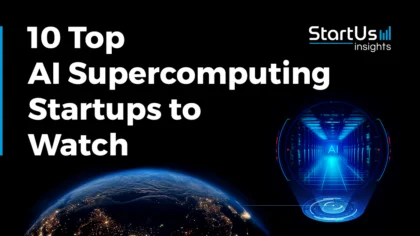Accelerate Productivity in 2025
Reignite Growth Despite the Global Slowdown
Executive Summary: Which are the Top 10 AI Supercomputing Startups & Companies to Watch?
- Clussys – CXL-powered interconnects that unify GPU/CPU clusters with low latency and power draw.
- Analog Physics – Neutral-atom quantum AI processors offering exact, real-time inference.
- Sharon AI – GPU-as-a-service with liquid cooling and InfiniBand for cost-efficient, high-availability compute.
- NcodiN – Photonic chiplet interposers delivering petabit-scale links at ultra-low energy per bit.
- Flow Computing – PPUs that boost CPU throughput by orders of magnitude for AI workloads without code changes.
- PureNodal – Liquid-cooled, software-defined nodes providing sub-15 ms latency in a distributed AI-HPC cloud.
- AION – Blockchain-backed GPU marketplace turning idle resources into tradable compute capacity.
- Invigion Technologies – Photonic accelerator cards that slash energy and latency for matrix operations.
- WAIYS – High-density, liquid-cooled containers packing megawatt-scale supercomputing in modular units.
- Nscale – Bare-metal GPU hyperscaler with serverless inference APIs and renewable-powered data centers.
As AI workloads grow in scale and complexity, supercomputing has become essential to support next-generation models, simulations, and autonomous systems. The global AI supercomputer market is projected to reach USD 3.3 billion by 2028 at a compound annual growth rate (CAGR) of 22% from 2023 to 2028.
This article highlights 10 startups building advanced infrastructure from photonic processors and quantum AI engines to decentralized networks and hyperscalers. These companies are redefining AI computation through high-density platforms, parallel processing units, and cloud-native supercomputing environments tailored for large-scale intelligence.
Global Startup Heat Map highlights Emerging AI Supercomputing Startups to Watch
Through the Big Data & Artificial Intelligence (AI)-powered StartUs Insights Discovery Platform, covering over 7M+ startups, 20K+ technology trends plus 150M+ patents, news articles & market reports, we identified 40+ AI supercomputing startups.
The Global Startup Heat Map below highlights emerging AI supercomputing companies you should watch in 2025 as well as the geo-distribution of 40+ startups & scaleups we analyzed for this research.
According to our data, we observe high startup activity in Southeast Asia and Western Europe, followed by the United States. The top 5 Startup Hubs for AI supercomputing are Singapore, Tokyo, London, Bangalore, and Amsterdam.
Meet Emerging AI Supercomputing Startups to Watch in 2025
We hand-picked startups to showcase in this report by filtering for their technology, founding year, location, funding, and other metrics. These emerging AI supercomputing solutions range from quantum artificial intelligence and PPU-accelerated AI supercomputing to photonic-based AI processor accelerators and vertically-integrated AI hyperscalers.
1. Clussys
- Founding Year: 2022
- Location: Shanghai, China
- Use for: CXL-based AI Interconnect
Clussys is a startup that develops high-speed interconnect architectures for GPU and CPU clusters. Its technology employs a PCIe Net + PCIe/CXL direct connection framework that enables efficient data transmission between GPUs and CPUs across multiple nodes.
The startup addresses the increasing computational demands of AI model training by facilitating multi-GPU and multi-CPU communication. It also offers multi-PCIe/CXL switch chips and solutions to overcome domestic GPU cluster interconnection challenges.
Clussys enhances the performance and efficiency of AI supercomputing infrastructures by reducing interconnection costs, increasing storage density, and lowering the system’s power consumption.
2. Analog Physics
- Founding Year: 2024
- Location: Kalispell, MT, US
- Use for: Quantum Artificial Intelligence (QAI)
Analog Physics offers QAI NeuronQ, a deterministic quantum artificial intelligence platform. It integrates optically trapped neutral-atom processors, high-fidelity Vulkan GPU simulations, and neuromorphic direct-drive control to deliver mathematically exact solutions in real time.
The platform features proactive quantum error prevention, one-shot learning for zero-shot inference, and integration with large language models (LLM) for natural language interaction. It addresses complex, mission-critical challenges across sectors like defense, cybersecurity, healthcare, and autonomous systems.
3. Sharon AI
- Founding Year: 2023
- Location: Sydney, Australia
- Use for: AI Infrastructure
Sharon AI delivers AI infrastructure through its GPU-as-a-service platform. It provides scalable, high-performance computing for artificial intelligence and high-performance computing workloads.
The startup’s architecture integrates a fleet of NVIDIA and AMD GPUs interconnected via high-speed InfiniBand networks to support compute-intensive tasks. It features proprietary compute architecture, direct-to-chip liquid cooling, and enterprise-grade reliability to ensure efficient processing and scalability.
Sharon AI enables organizations to accelerate innovation and achieve significant advancements in AI development by offering flexible, cost-effective, and energy-efficient AI infrastructure.
4. NcodiN
- Founding Year: 2024
- Location: London, UK
- Use for: HPC Optimization
NcodiN develops an optical interposer that integrates nanoscale photonic components to enable high-bandwidth, low-latency chiplet communication in AI supercomputing systems. It replaces traditional electrical interconnects with energy-efficient photonic links, transmitting data at Petabit-per-second speeds while consuming under 0.1 pJ/bit.
It supports dense chiplet integration and scalable architectures by embedding nanolasers and detectors directly onto silicon. This design enhances performance for AI workloads such as model training and inference by reducing interconnect bottlenecks.
NcodiN enables more efficient and powerful AI high-performance computing platforms optimized for parallel data movement and advanced memory and compute coordination.
5. Flow Computing
- Founding Year: 2024
- Location: Helsinki, Finland
- Use for: PPU-Accelerated AI Supercomputing
Flow Computing provides a parallel processing unit (PPU) that integrates with standard CPUs to create SuperCPUs, high-performance heterogeneous compute systems optimized for AI workloads.
The PPU accelerates parallel workloads by executing thousands of threads simultaneously to increase CPU throughput by up to 100 times. It also uses an on-chip high-bandwidth architecture with low-latency synchronization to support intensive AI tasks like training LLMs and real-time inference.
The PPU also retains software compatibility that results in performance gains through recompilation. This enables scalable, energy-efficient AI supercomputing without separate GPU accelerators, while reducing system complexity and improving local compute performance.
Want to Explore 40+ AI Supercomputing Startups & Scaleups?
6. PureNodal
- Founding Year: 2023
- Location: Irving, TX, US
- Use for: Distributed AI-HPC Cloud Infrastructure
PureNodal develops a decentralized cloud infrastructure platform for AI and high-performance computing workloads. It utilizes liquid immersion cooling and modular data center design to deploy dense compute clusters with reduced energy and space requirements.
The platform integrates software-defined networking (SDN) and a nodal architecture to achieve sub-15ms latency and high-throughput data transfer. It supports tasks such as large-scale model training and real-time inference.
It also combines GPU-accelerated compute, NVMe-based storage, and scalable deployment for enterprises to process complex workloads efficiently.
7. AION
- Founding Year: 2024
- Location: New York City, NY, US
- Use for: Decentralized AI Infrastructure
AION builds a decentralized AI infrastructure that converts distributed GPU resources into a unified, blockchain-secured compute layer. It transforms idle computational resources into a globally accessible, tradable asset.
It enables enterprises, developers, and individuals to rent or monetize GPU capacity through a decentralized marketplace. Its decentralized model promotes innovation by allowing a diverse range of participants to contribute to and benefit from the AI economy.
8. Invigion Technologies
- Founding Year: 2024
- Location: Bangalore, India
- Use for: Photonic-based AI Processor Accelerators
Invigion Technologies offers photonic-based AI processor accelerators to enhance computational efficiency in AI-driven applications. Its AI Accelerator Server Card utilizes photonic technology to perform data processing using light. This approach reduces energy consumption and heat generation compared to traditional electronic processors.
The AI edge computing accelerator chipset applies similar principles to edge devices for enabling rapid data processing and minimal latency. These products leverage the inherent parallelism of photonic systems to accelerate matrix operations and convolutions.
Invigion Technologies’ accelerators offer improvements in processing speed and energy efficiency to address the growing demands of AI workloads.
9. WAIYS
- Founding Year: 2023
- Location: Oslo, Norway
- Use for: High-Density Supercomputing Infrastructure
WAIYS provides high-density supercomputing infrastructure through modular data center containers. It utilizes liquid-cooled, rack-dense systems that integrate neuromorphic hardware and spiking neural networks to process large-scale, low-latency workloads at the edge or in centralized deployments.
The infrastructure supports between 350 kW and 2.5 MW per container. This enables dense compute capacity within a compact footprint. Each unit accommodates up to 10 AI/HPC racks and includes built-in power distribution, cooling, and heat recovery systems.
The units optimize thermal efficiency through hot-water cooling and enable direct integration with energy reuse systems. This offers a scalable and energy-conscious compute backbone.
10. Nscale
- Founding Year: 2024
- Location: London, UK
- Use for: Vertically-Integrated AI Hyperscaler
Nscale develops a vertically integrated AI and HPC cloud platform that provides on-demand access to bare-metal GPU nodes. The startup’s infrastructure supports large-scale AI workloads like model training, inference, and fine-tuning.
For this, the startup combines high-performance hardware with orchestration tools like Kubernetes and Slurm. The platform also offers serverless inference APIs for deploying generative AI models without managing infrastructure.
Moreover, Nscale’s modular data centers utilize renewable energy and adiabatic cooling for energy efficiency. This enables scalable, efficient, and environmentally responsible AI supercomputing.
Discover All Emerging AI Supercomputing Startups
The AI supercomputing startups showcased in this report are only a small sample of all startups we identified through our data-driven startup scouting approach. Download our free Industry Innovation Reports for a broad overview of the industry, or get in touch for quick & exhaustive research on the latest technologies & emerging solutions that will impact your company in 2025!


![Top 30 SaaS Startups & Companies to Watch [2026 & Beyond]](https://www.startus-insights.com/wp-content/uploads/2025/09/SaaS-Startups-SharedImg-StartUs-Insights-noresize-420x236.webp)





